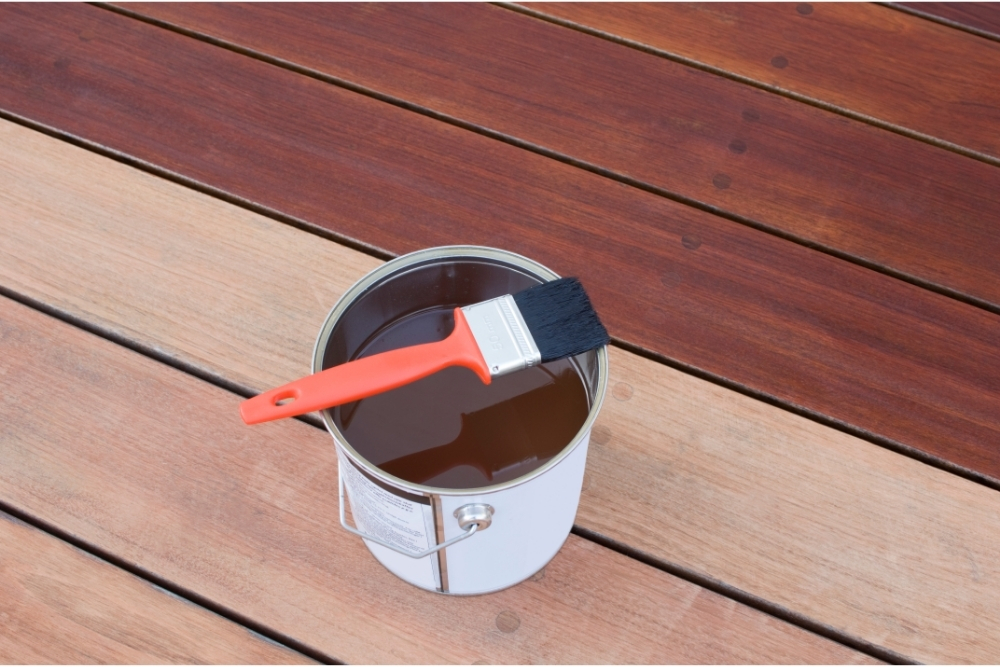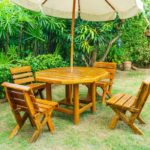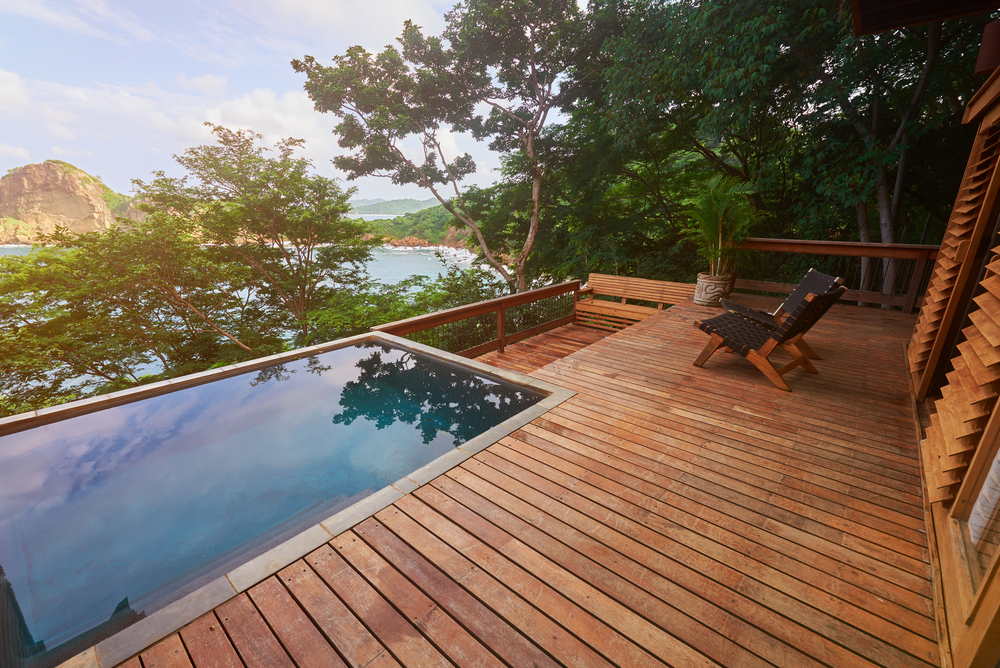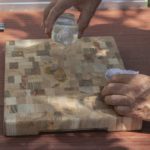Oils, stains, and finishes can drastically change outdoor furniture. These applications can transform and protect patio sets for years. But, what’s the best stain for outdoor furniture? Does it matter if you use an oil or water based stain? Do you need a stain that is specific to the type of wood you’re staining?
We recommend using an oil-based stain like Ready Seal, because oil-based stains soak into the pores of the wood, protecting it from the inside out. Water-based options like DEFY Extreme create a protective coating on the outside. Both options need to be re-applied periodically for the best results.
Although Ready Seal is our best recommendation, it may not serve every purpose. Stains and finishes have different pros, cons, and uses. For that reason, it’s best to do your research and read manufacturer’s guidelines before making a final decision. So, here’s everything you need to know about the best stains for outdoor furniture!
What’s the Best Stain To Use for Outdoor Wood Furniture?
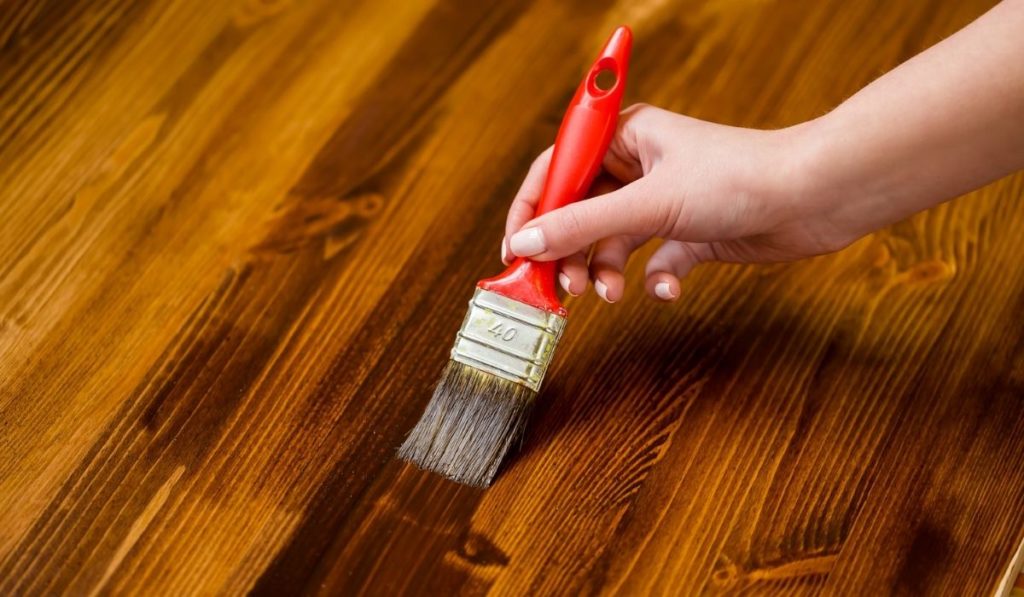
Before you can determine which strain is best suited for your outdoor wooden furniture, you’ll first need to consider your needs. Each type of stain and product will have its own set of advantages, disadvantages, and best-use cases.
Different Stain Types
Different exterior wood stains are made using a variety of ingredients. You have a few choices when it comes to stain type, including water-based or acrylic, oil-based, and hybrids. The names of each stain refer to the main liquid that the manufacturer uses to mix the pigments and additives.
Although our recommendation is the oil-based Ready Seal (on Amazon) , the water-based DEFY Extreme (also on Amazon) will do just fine. That said, we’re also going to look into wood-specific stains like Teak Oil (also on Amazon) and talk about the pros and cons of going that direction.
Water-Based & Acrylic Stains
As you’ve probably guessed, water-based or acrylic stains use water as their main ingredient. Water-based stains can be relatively easy to apply. The clean-up process is straightforward and requires a bit of warm soapy water.
An additional benefit to this stain type is that they have a low-VOC (volatile organic compound) content. This means water-based stains are better for the environment than their counterparts.
However, water-based and acrylic stains won’t penetrate wood quite as deeply as oil-based varieties. This means your stain may not last as long or provide as much protection. If you don’t mind reapplying finishes and are looking for the fastest solution, water-based stains are right for you.
Oil-Based Stains
Oil-based stains use oil as their main ingredient. These stains deeply penetrate wooden surfaces, getting into all the nooks and crannies. This means oil-based stains and finishes can last longer than other varieties. Oil-based stains provide a stable layer of protection from moisture, debris, and natural elements.
However, the cleanup process can be a headache and often requires mineral spirits. Oil-based stains can also be irritating to the skin, eyes, and respiratory system, so it’s crucial you take safety precautions before beginning a project.
Film-Forming vs. Penetrating Stain
Different products will protect wood furniture in various ways. Some products will deeply penetrate the wood grain, protecting it from UV rays and water damage. Other stains create a protective barrier and film, completely encapsulating the wood. Each of these products has its own set of advantages, disadvantages, and best use cases.
Stains that penetrate deep into the pores of the wood strengthen the bongs of the material, protecting it from the inside out. These types of stains are long-lasting, durable, and aesthetically pleasing. However, these stains can showcase blemishes and damage if applied improperly.
Film-forming stains act as a shell, protecting the wood from the outside. These types of stains can hide irregularities like cracks or wear and tear. However, film-forming stains aren’t as robust compared to their counterparts. These stains may require frequent reapplications depending on your climate and usage.
Outdoor Wood Needs Exterior-Grade Stains
If you’re planning to stain outdoor patio furniture, you should opt for exterior-grade stain. Exterior-grade stains preserve the wood in rougher environments for longer periods of time compared to interior-grade varieties.
Consider Your Climate
Some stains and finishes are better suited for decks, patios, and large surfaces. If you’re staining a larger area, you should consider products with UV resistance. UV resistance will ensure your wood isn’t fading or warping over time.
Consider The Color
Choosing the color of your stain is definitely the most enjoyable part. However, the color of the stain can affect your furniture and the final result of your project. Darker stains are going to draw more sunlight. Extra sunlight can cause your outdoor furniture to warp, fade, and even deteriorate.
Transparency
Another factor to consider when deciding on a stain is the level of transparency. There are three main degrees of transparency: transparent stains, semi-transparent stains, and semi-solid stains.
Transparent stains are entirely see-through and opaque. These stains will rarely change the color of the natural wood more than a shade or two. These stains won’t hide any of the wood grain or premature wear and tear. The downside to transparent stains is that they don’t last as long as other varieties.
Semi-Transparent stains will last longer than transparent varieties. This type of stain will hide more of the wood’s grain, changing the look entirely. Semi-Transparent stains can also be used for hiding and blending blemishes.
Semi-Solid stains last the longest out of all the varieties mentioned. This type of stain does an excellent job of blending the grains of wood while covering blemishes. Semi-Solid stains work best for patio decks, shingles, and even outdoor furniture.
What is the Best Oil-Based Outdoor Wood Furniture Stain?
Oil-based outdoor stains are commonly made with linseed oil and mineral spirits. Oil-based stains penetrate wooden furniture more deeply, resulting in richer hues. This type of stain has excellent adhesive and conditioning properties that protect your furniture from peeling, cracking, and other damages.
However, oil-based stains will require a longer drying time of up to two days. Another disadvantage of oil-based stains is that they can leave your furniture vulnerable to moisture damage. So, what’s our top pick?
Ready Seal Exterior Wood Stain and Sealer
Ready Seal (on Amazon) is a long-trusted brand for craftsmen, woodworkers, and hobbyists all across the globe. This oil-based stain is semi-transparent and can be applied at nearly any temperature.
Ready Seal acts as a layer of defense against moisture, debris, and other damages. At first, the stain will appear dark, but in two weeks, you’ll find your furniture looks much richer and brighter than before.
Want to know the best part of Ready Seal? Ready Seal doesn’t require a primer for you to start, reducing the overall amount of work required. This product is available in the wooden hues of Natural Cedar, Golden Pine, Mahogany, Redwood, Burnt Hickory, Dark Walnut, Light Oak, and Pecan.
Other Oil-Based Wood Stains to Consider
Ready Seal is without a doubt the best oil-based stain on the market. However, if you’re branching out and want to try a new product, what options do you have?
You can use different varieties of wood oils to stain and protect your outdoor furniture. Some of the most durable wood oils include Danish oil, Teak oil, and Tung oil.
Danish Oil
Danish oil is considered a favorite, as it is more water-resistant and protective than the Tung Oil and Linseed varieties. Danish Oil provides a hard protective coating after drying, making it an excellent choice for outdoor furniture sets. This oil has a drying time of 4-6 hours, making it incredibly convenient to use.
Teak Oil
Teak Oil was originally made from teak wood. Nowadays, you can find Teak Oils made from just about any wood variety. This oil is perfect for close grain woods, as it can penetrate deeper than other oils.
Teak oil gives the wood a warm finish and can be applied to indoor and outdoor furniture sets. Teak Oil is notably easy to use and only takes 4-6 hours to completely dry. This oil also has a Matte finish, similar to Tung Oil.
Tung Oil
Tung oil is non-toxic and has been used for hundreds of years. This oil derives from the seed of tung trees. Tung oil is more water-resistant and dries faster than Linseed Oil.
However, Tung Oil requires more coats than other options. With this oil, you’ll have to apply up to five coats for the best results. This oil also takes longer to dry at around a total of 24 hours and has a Matte finish.
What is the Best Water-Based Outdoor Wood Furniture Stain?
If you’re more concerned about the environment or have less time on your hands, you should opt for water-based stains. Water-based stains lock out water and moisture as they allow your furniture to breathe.
However, these stains don’t penetrate wooden surfaces as easily as their oil-based counterparts.
If you’re looking for something quick and simple, go with water-based stains. Water-based stains are ideal for beginners, porous woods, and quick projects. Can you guess what our top water-based stain is?
DEFY Extreme Semi-Transparent Exterior Wood Stain
DEFY Extreme (on Amazon) is the ideal water-based wood stain for beginners and veterans alike. This high-end stain leaves a durable, matte finish that will resist the elements for years to come.
Keep in mind you’ll need to remove any previous stains or sealants before applying DEFY. You can select from colors such as Butternut, Natural Pine, Driftwood Gray, Cedar Tone, Light Walnut, Redwood, and Crystal Clear.
How to Choose the Right Stain for My Outdoor Furniture
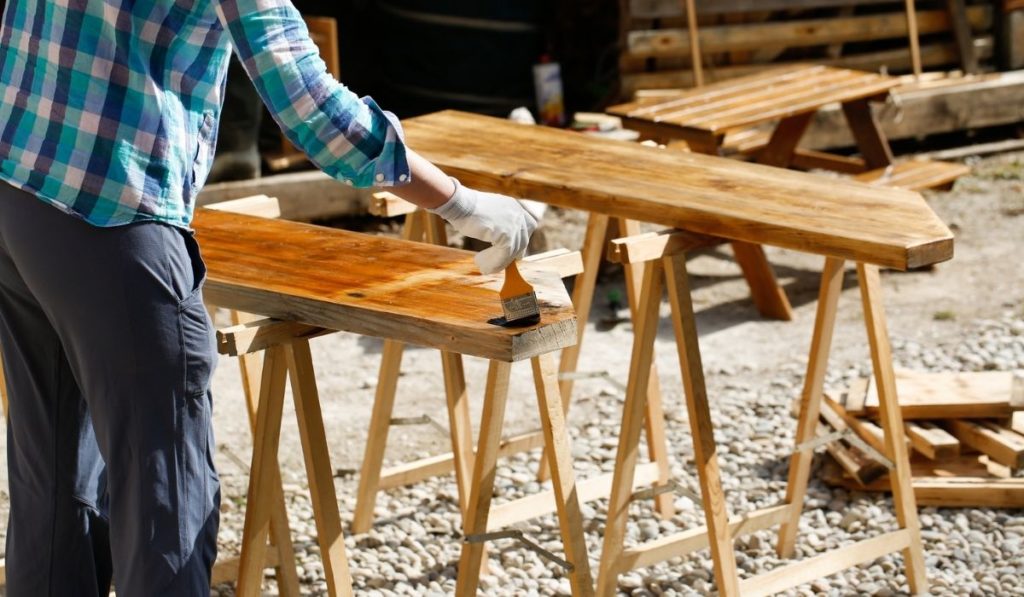
As you can see, there are multiple varieties of strains and products to choose from. Different stains will have their own pros and cons, making it difficult to choose the perfect product. So, how can you choose the best stain for your outdoor wooden furniture?
Consider The Whole Picture
Outdoor furniture is an extension of your home, style, and personality. Before you begin selecting color pallets and comparing brands, consider the bigger picture.
Choose stains and finishes that compliment the exterior of your house. Consider taking inspiration from the environment around you, your home, or your landscape. Choosing hues and colors that complement each other will give your home a more cohesive look inside and out.
Oils, Varnishes, or Lacquers?
Before you can begin staining your beautiful wooden furniture, you’ll need to choose a product type. You can select from various wood oils, varnishes, lacquers, and polyurethane sealants.
Wood oils provide organic protection to wooden furniture and enhance natural beauty. Varnishes will take more work, requiring multiple coats. Lacquers and polyurethane sealants will vary in labor but have the most diversity of finish.
How Much Time Can You Commit?
Although we may want the very best all-natural finish, the process might take too long to make sense. Choosing the best stain or finish will partially come down to how much effort you’re willing to exert. Different sealants and finishes require more time. If you don’t have a full weekend to dedicate to one project, you might be better off going with a less intensive sealant.
What’s Your Climate Like?
Some finishes do better in different climates. If you live in a naturally sunny environment, you’ll want to look for sealants suited for UV Rays. Alternatively, if you live in wet and rainy conditions, you’ll want a moisture-resistant sealant.
When choosing the best product, consider your environment and needs. Maybe you want something non-toxic to protect your backyard, pets, and family. Regardless of your needs, there is sure to be a product best suited for you.
Are You Staining or Sealing?
If you didn’t know by now, there are staining products, sealing products, and all-in-one combo solutions. Using an all-in-one product can save time and be an efficient way to protect your furniture. However, either option can benefit your outdoor wooden pieces, so the choice will come down to preference.
Consider The Woods Condition
Before starting a new project, you’ll want to consider your wood’s condition. Different ages of wood will have different requirements and best-use cases.
- New wood for construction projects will benefit from clear and transparent stains. Semi-transparent and transparent stains can enhance the natural appearance of wood that’s already been treated.
- If you have a project with multiple types of wood, you should use semi-solid stains to create a uniform appearance without losing the grain in the process.
- Damaged wood with visible wear and tear should be sanded and primed before stained. Use solid stains to cover visible damage, stains, or wear and tear.
Consider Wood Type
You should also consider the type of wood you’re using for your project. Different woods will have different advantages, disadvantages, and best-use cases.
For example, newer woods benefit from two-in-one stain and sealer combination products. Ready Seal (on Amazon) is one of the stains you should be considering.
Softwoods like cedar and redwood need to be stained and sealed for longevity. This means you should use more products that are more durable and long-lasting for these types of projects. Consider oil-based stains as opposed to water-based.
Hardwoods like teak, ipe, or Brazilian Ash are the complete opposite. Hardwoods are dense, strong, and robust, so staining them isn’t always necessary for their longevity.
Can I Use Wood Stain on My Outdoor Furniture?
As mentioned earlier, wood stain is a fine choice for outdoor furniture. You can use any variety of wood stains or oil on your wooden patio set. However, be sure the product meets your specific needs and project.
For the best results, read all the manufacturer’s instructions and guidelines before beginning.
What is the Most Durable Outdoor Wood Furniture Stain?
So, ready to hear what the most durable outdoor wood furniture stain is?
The number one recommended wood furniture stain has to go to Ready Seal Exterior Stain and Sealer for Wood (on Amazon). This product needs no introduction as it is loved by craftsmen and hobbyists across the globe.
Ready Seal is an oil-based stain that is semi-transparent and can be applied at nearly any temperature. Ready Seal acts as a layer of defense against moisture, debris, and other damages. At first, the stain will appear dark. In two weeks, though, you’ll find your furniture looks much richer and brighter than before.
Ready Seal is suited for all individuals and skill levels. You can find these stains in colors, such as Natural Cedar, Golden Pine, Mahogany, Redwood, Burnt Hickory, Dark Walnut, Light Oak, and Pecan.

